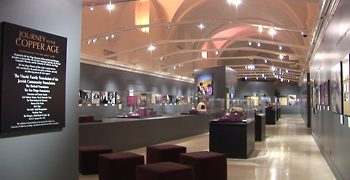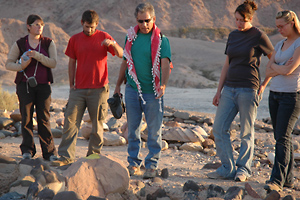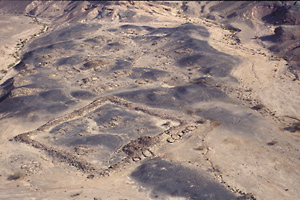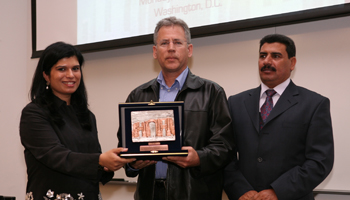Journey to the Copper Age: Tracing the History of a Technological Revolution
By Doug Ramsey, 858-822-5825, dramsey@ucsd.edu
San Diego, CA, June 19, 2007 -- San Diegans are getting a chance to travel back in time to the Middle East in pre-Biblical times, some 6,000 years ago. Their time machine is a new exhibition at the San Diego Museum of Man.
|
“Journey to the Copper Age” opened to the public last week to rave reviews and it is guest-curated by UCSD archaeologist Tom Levy. The show features many of the relics uncovered by Levy on a series of digs over the past two decades in Israel and Jordan, as well as his ethno-archaeological research in India.
According to Levy, the exhibit traces the evolution of human society in the wake of fundamental technological change – notably the birth of metal technology and humans’ ability to transform matter.
“This exhibit and our academic research in India and the Middle East show us the powerful role of technological change in shaping societies,” says Levy. “I go back to the comparison with the information-technology revolution and its impact on us over the past 25 or 30 years: it’s the powerful transformation of our society, like what went on with the metal revolution.”
|
More recently, Levy uncovered the largest ancient copper factory, dating back 3,000 years to the time of King David and other Biblical figures. Every summer the Department of Anthropology professor takes graduate and undergraduate students to the site in Jordan’s Faynan district, where they spend two months methodically – and painstakingly – excavating the ruins at Khirbat en-Nahas. The site remains visible via satellite, thanks to its blackened surface -- betraying thousands of tons of black metallurgical slag produced by the long-ago metal workshops.
|
Levy is the inaugural holder of UCSD’s the Norma Kershaw Endowed Chair in the Archaeology of Ancient Israel and Neighboring Lands. Since 1997, his research has focused on the role of mining and metallurgy in early societies of southern Jordan. Says Levy: “I’ve tried to use metalworking as a lens to study social evolution.”
|
While most of the exhibit features artifacts from the Middle East, “Journey to the Copper Age” also takes visitors to a small town in the south of India. In a half-hour documentary produced by the UCSD division of Calit2, Levy visits a workshop in Swamimalai where hereditary bronze casters – hereditary, because most can trace their family profession back 1,000 years -- use a technology that the UCSD expert believes may have been used by Copper Age artisans.
The “lost wax” method involves carving a wax model, then building a mold around it and heating it enough to dissolve the wax, which is drained out of the mold, before molten metal is then poured in. The video documents the process as the metal workers use the lost wax method to make a replica of a twin-headed ibex mace head discovered in 1961 in the Cave of the Treasure.
|
The exhibition is settling in for a long run at the Museum of Man; it will be on display through next February. It is expected to draw a growing crowd of interested museum-goers this summer, thanks in part to another exhibition in Balboa Park, when some of the Dead Sea Scrolls go on display at the Natural History Museum. Levy notes the irony that the signature piece of “Journey to the Copper Age” was found at the Cave of the Treasure by archaelogists looking for the Dead Sea Scrolls. What they found instead was the treasure trove of 6,000-year-old copper objects, whereas the Dead Sea Scrolls date back barely 2,000 years.
Levy was in San Diego for the opening, but a few days later jumped on a plane. With wife and collaborator Alina, he is already headed back to Jordan for the summer dig season, and more than a dozen UC San Diego students will be joining them at the Jordanian site.
Related Links
Journey to the Copper Age
Thomas Levy Bio






